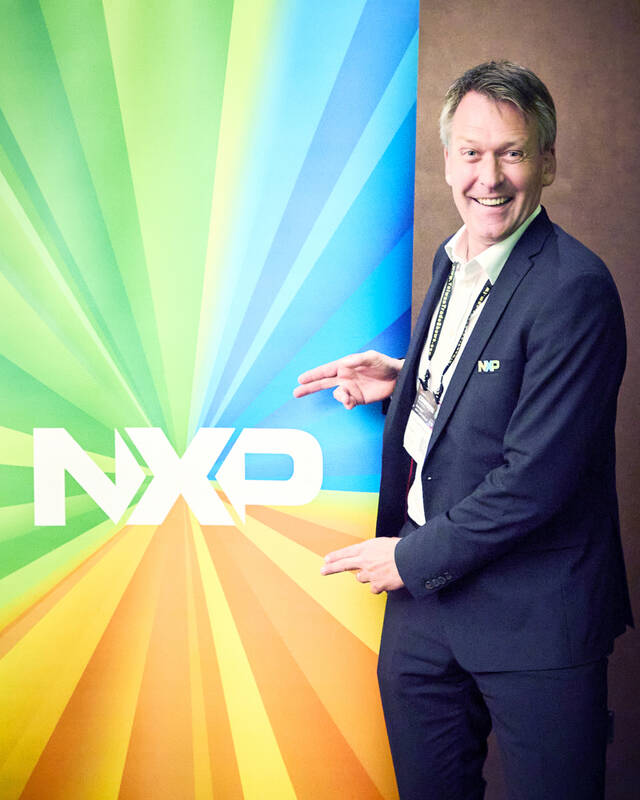NXP Semiconductors NV said it is seeking to diversify its manufacturing capacity geographically to further enhance chip supply resilience together with its Taiwanese foundry partners amid the uncertainty of geopolitical tensions and natural disasters.
NXP made the remarks after it announced a new joint venture with Vanguard International Semiconductor Corp (VIS, 世界先進) on Wednesday.
The companies plan to invest US$7.8 billion to build a 12-inch fab in Singapore, and the joint venture, VisionPower Semiconductor Manufacturing Co, would begin construction of the fab in the second half of this year at the earliest.

Photo courtesy of NXP Semiconductors NV
“Chip storage is one of the key topics we need to address,” NXP chief technology officer Lars Reger told a media briefing on Thursday.
To prevent a recurrence of the chip supply disruptions of 2021, automakers requested chip supplies from two different continents or from two foundry vendors, Reger said.
NXP is also boosting its in-house capacity and seeking external supply from foundry partners, he added.
Similar to the creation of the joint venture European Semiconductor Manufacturing Co (ESMC), the aim is to have a significant share to secure and have a supply capability in place, Reger said in response to a question about the company’s rationale behind the Singapore investment and NXP’s capacity outsourcing strategy.
ESMC is a joint venture between Taiwan Semiconductor Manufacturing Co (TSMC, 台積電), NXP, Robert Bosch and Infineon Technologies AG. The fab, which would cost more than 10 billion euros (US$10.83 billion), is to produce 16-nanometer and 28-nanometer chips when it starts operations in 2027.
TSMC produces NXP’s S32 series chips using its 5-nanometer technology at a fab in Taichung, Reger said.
Aside from geopolitical tensions, natural disasters are also put into consideration, he said.
Severe flooding in Germany one-and-half years ago damaged a copper wire factory and caused a deficiency of chip supply, Reger said. The copper wires are key materials for wire bonding interconnects, a chip packaging solution.
The fab in Singapore is to produce power management chips used in cars and robots, rather than complementary metal-oxide-semiconductor image sensors, which already have a sufficient supply in the market, Reger said on concerns over potential overcapacity.
“Don’t be irritated by the current recession we have,” Reger said.
Asked why it selected Singapore as the place to build its first 12-inch fab with VIS, Reger said talent acquisition is one of the major reasons.
“There’re not many ecosystems that can offer good talent,” he said.
Taiwan, South Korea, Singapore, south Germany, France and some locations in the US are semiconductor hot spots to build fabs today,” Reger added.
NXP also has experience in working with partners in Singapore, as it had formed a joint venture with TSMC, Systems on Silicon Manufacturing Co (SSMC), in the city state more than 20 years ago, Reger said. SSMC produces analog chips, including power management chips.

UNCERTAINTY: Innolux activated a stringent supply chain management mechanism, as it did during the COVID-19 pandemic, to ensure optimal inventory levels for customers Flat-panel display makers AUO Corp (友達) and Innolux Corp (群創) yesterday said that about 12 to 20 percent of their display business is at risk of potential US tariffs and that they would relocate production or shipment destinations to mitigate the levies’ effects. US tariffs would have a direct impact of US$200 million on AUO’s revenue, company chairman Paul Peng (彭雙浪) told reporters on the sidelines of the Touch Taiwan trade show in Taipei yesterday. That would make up about 12 percent of the company’s overall revenue. To cope with the tariff uncertainty, AUO plans to allocate its production to manufacturing facilities in

Taiwan will prioritize the development of silicon photonics by taking advantage of its strength in the semiconductor industry to build another shield to protect the local economy, National Development Council (NDC) Minister Paul Liu (劉鏡清) said yesterday. Speaking at a meeting of the legislature’s Economics Committee, Liu said Taiwan already has the artificial intelligence (AI) industry as a shield, after the semiconductor industry, to safeguard the country, and is looking at new unique fields to build more economic shields. While Taiwan will further strengthen its existing shields, over the longer term, the country is determined to focus on such potential segments as

TAKING STOCK: A Taiwanese cookware firm in Vietnam urged customers to assess inventory or place orders early so shipments can reach the US while tariffs are paused Taiwanese businesses in Vietnam are exploring alternatives after the White House imposed a 46 percent import duty on Vietnamese goods, following US President Donald Trump’s announcement of “reciprocal” tariffs on the US’ trading partners. Lo Shih-liang (羅世良), chairman of Brico Industry Co (裕茂工業), a Taiwanese company that manufactures cast iron cookware and stove components in Vietnam, said that more than 40 percent of his business was tied to the US market, describing the constant US policy shifts as an emotional roller coaster. “I work during the day and stay up all night watching the news. I’ve been following US news until 3am

COLLABORATION: Given Taiwan’s key position in global supply chains, the US firm is discussing strategies with local partners and clients to deal with global uncertainties Advanced Micro Devices Inc (AMD) yesterday said it is meeting with local ecosystem partners, including Taiwan Semiconductor Manufacturing Co (TSMC, 台積電), to discuss strategies, including long-term manufacturing, to navigate uncertainties such as US tariffs, as Taiwan occupies an important position in global supply chains. AMD chief executive officer Lisa Su (蘇姿丰) told reporters that Taiwan is an important part of the chip designer’s ecosystem and she is discussing with partners and customers in Taiwan to forge strong collaborations on different areas during this critical period. AMD has just become the first artificial-intelligence (AI) server chip customer of TSMC to utilize its advanced